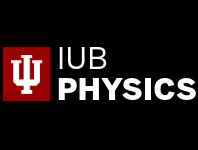Scientists from Indiana University are among the thousands of researchers worldwide honored with the 2025 Breakthrough Prize in Fundamental Physics, awarded to the ATLAS Collaboration at CERN's Large Hadron Collider (LHC) alongside its sister experiments ALICE, CMS and LHCb.
ATLAS is one of the largest and most complex scientific instruments ever built. As a general-purpose particle detector measuring over 40 metres in length and around 25 metres in height, it was designed to investigate the fundamental building blocks of matter and the forces governing our universe. Its cutting-edge systems track particles produced in particle collisions at unprecedented energies, enabling discoveries like the Higgs boson and searches for new physics beyond the Standard Model.
The Breakthrough Prize specifically highlights the ATLAS Collaboration’s significant contributions to particle physics, including detailed measurements of Higgs boson properties, studies of rare processes and matter-antimatter asymmetry, and the exploration of nature under the most extreme conditions.
“The Breakthrough Prize is a testament to the dedication and ingenuity of the ATLAS Collaboration and our colleagues across the LHC experiments,” said ATLAS Spokesperson Stephane Willocq. "This prize recognises the collective vision and monumental effort of thousands of ATLAS collaborators worldwide.”
“I am extremely proud to see the extraordinary accomplishments of the LHC collaborations honoured with this prestigious Prize,” said Fabiola Gianotti, Director-General of CERN. “It is a beautiful recognition of the collective efforts, dedication, competence and hard work of thousands of people from all over the world who contribute daily to pushing the boundaries of human knowledge.”
IU has been at the forefront of ATLAS research from its outset, contributing to:
- Construction and operation of the Transition Radiation Tracker, critical for identifying charged particles and measuring their momenta
- Development of the jet energy scale corrections and uncertainties, enabling measurements of the Higgs Boson as well as processes that test the Higgs mechanism, such as Vector Boson Scattering
- Leadership in Trigger and Data Acquisition, which shapes and governs the copious amounts of data that are used for ATLAS measurements and searches for physics signatures beyond the Standard Model
"The successes of Run 2 showcase the ingenuity of the ATLAS Collaboration — not only in collecting data with a detector of outstanding precision, but also in our relentless drive to improve our understanding of it," said Andreas Hoecker, former ATLAS Spokesperson.
While the ATLAS Collaboration celebrates the recognition of the Breakthrough Prize, its focus remains firmly on the future. The third operation period of the LHC is currently underway and preparations for the High-Luminosity LHC upgrade are advancing rapidly. Indiana University's team of 18 physicists and engineers, led by PIs Harold Evans, Sabine Lammers, Chris Meyer and Rick van Kooten, is deeply involved in preparing ATLAS for its next chapter. They are leading the development of the inner tracker data acquisition and the calorimeter trigger for the High-Luminosity LHC, which will increase collision rates tenfold when it begins operation in 2030.
“We are now preparing the ATLAS detectors of the future — designed to harness these unprecedented data and further push our understanding of the universe’s fundamental building blocks,” concludes Willocq.
General links:
ATLAS Official WebsiteCERN Official Website
HL-LHC Official Website



 The College of Arts
The College of Arts